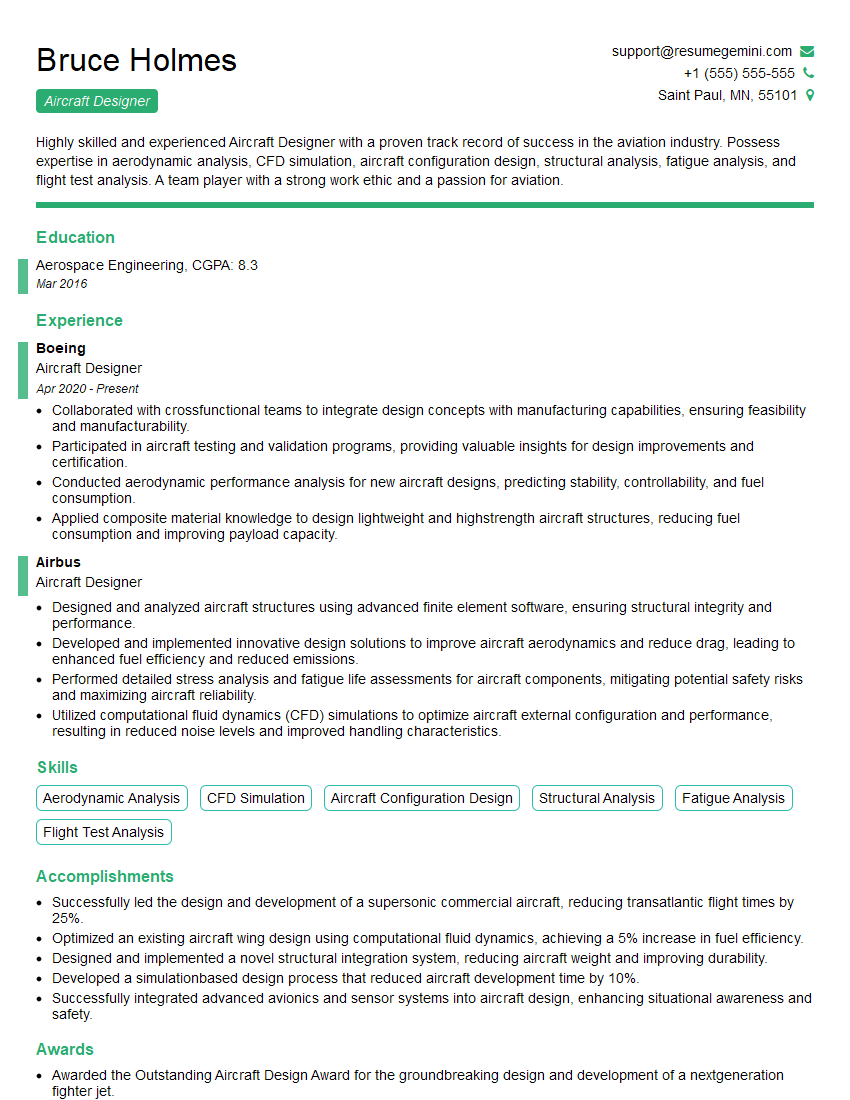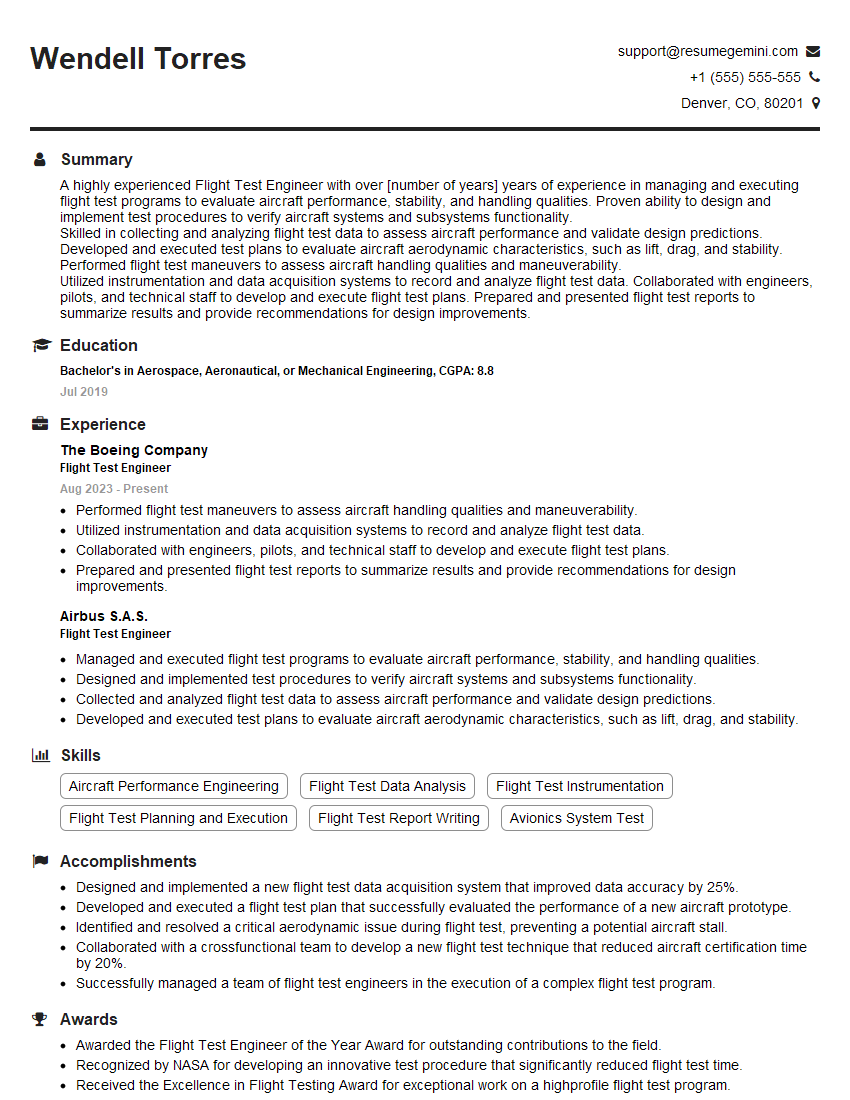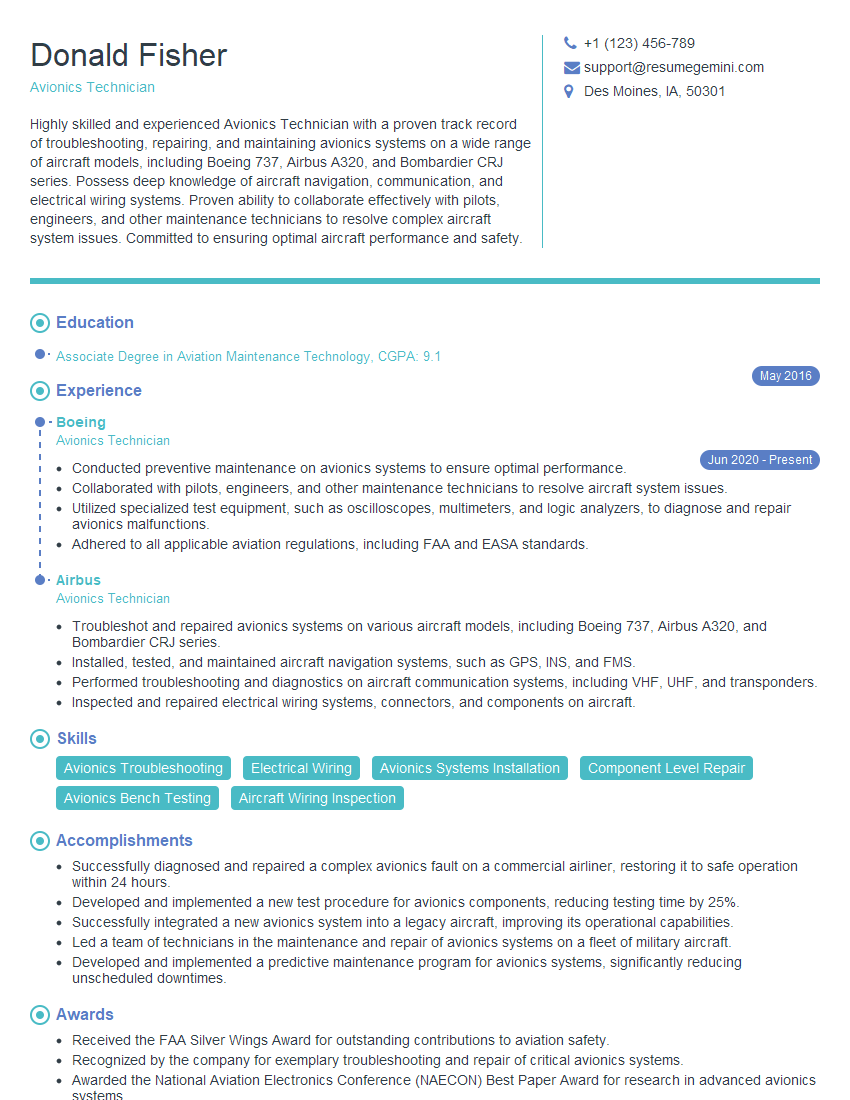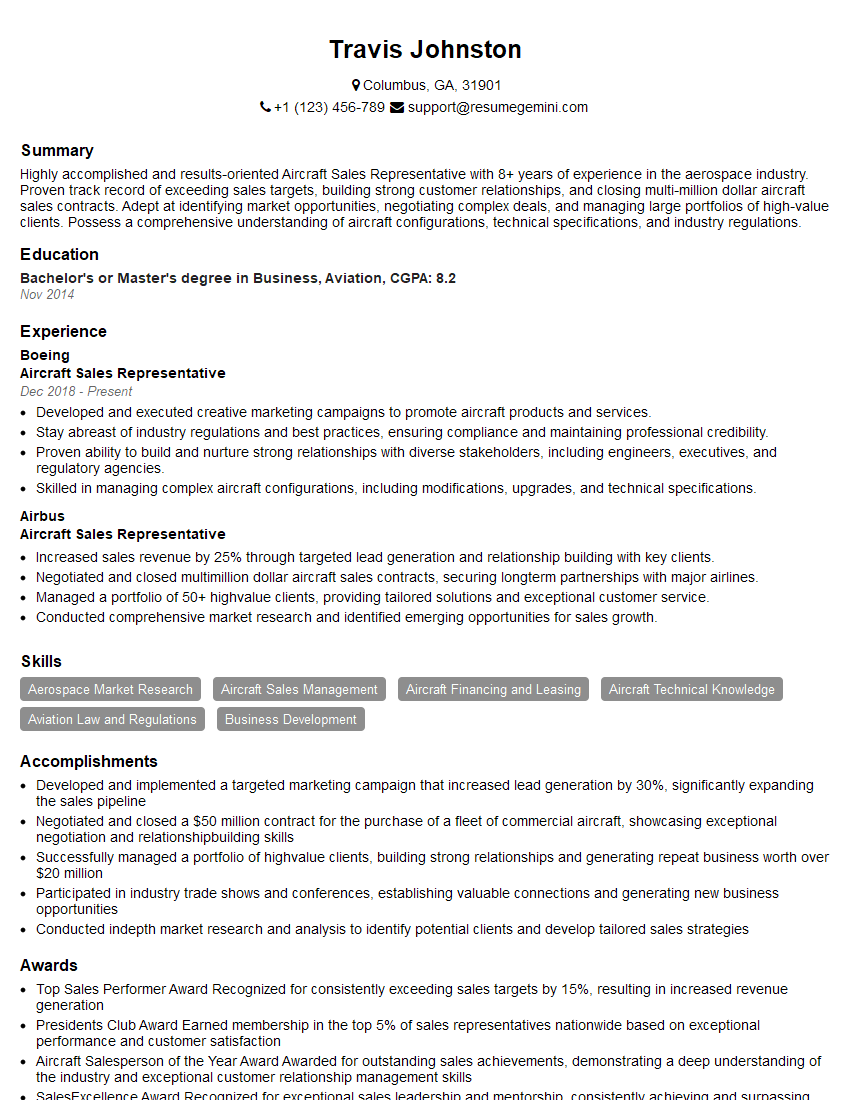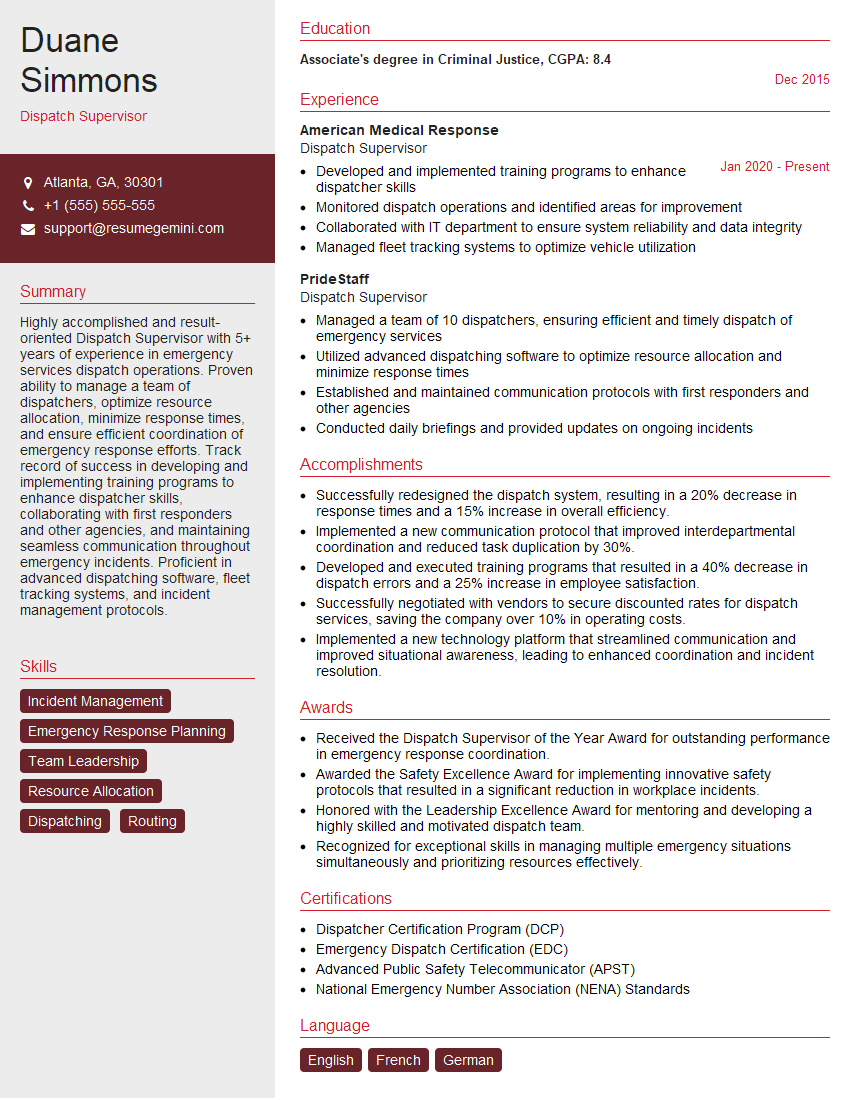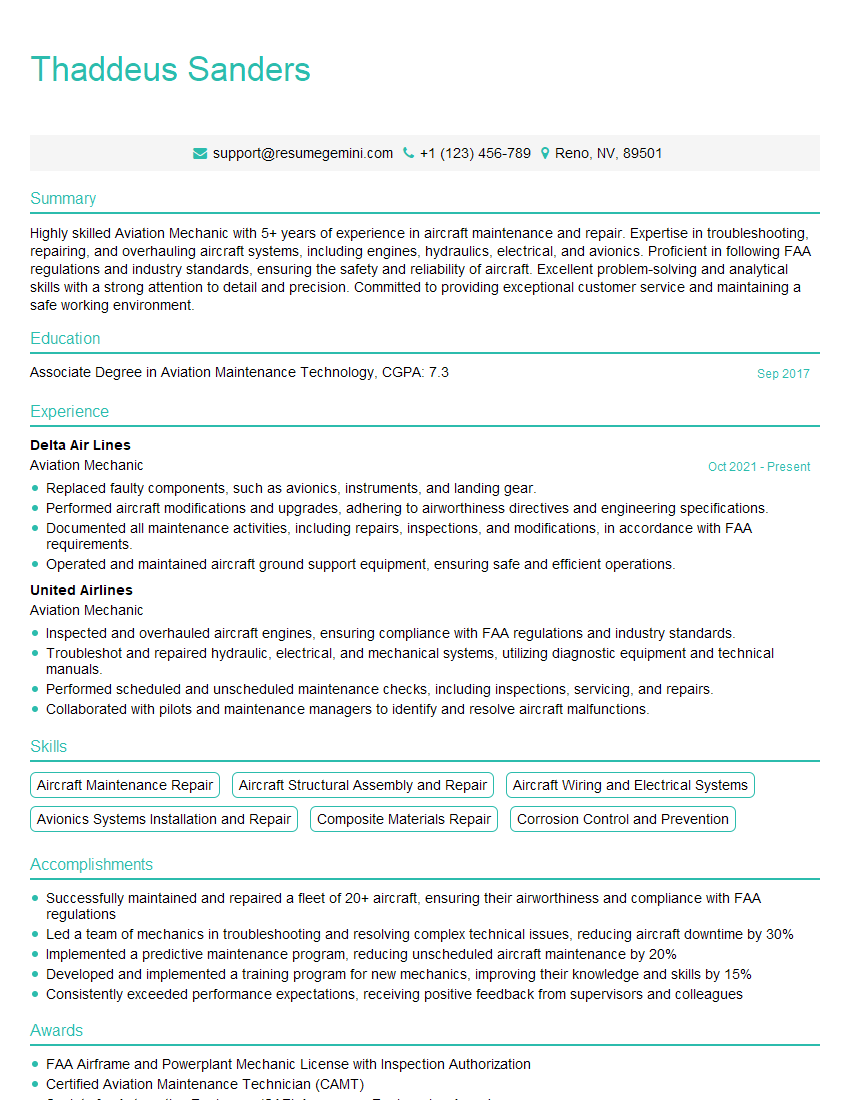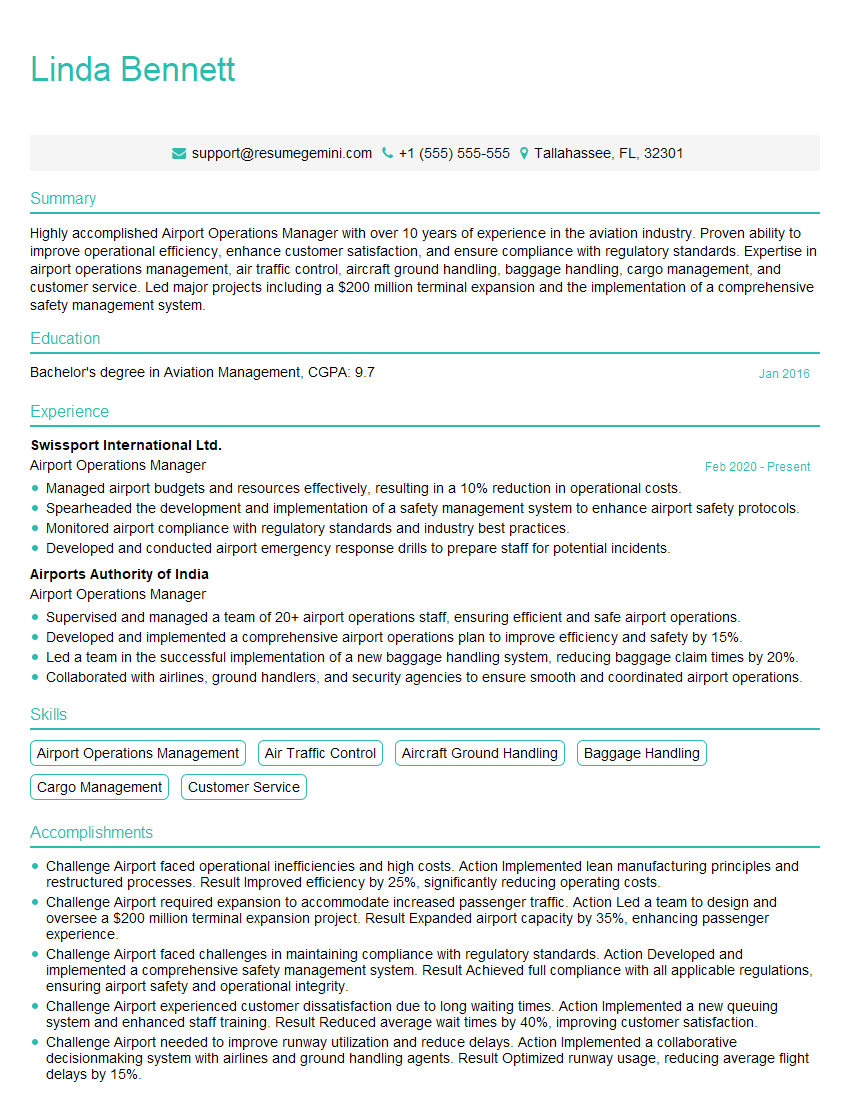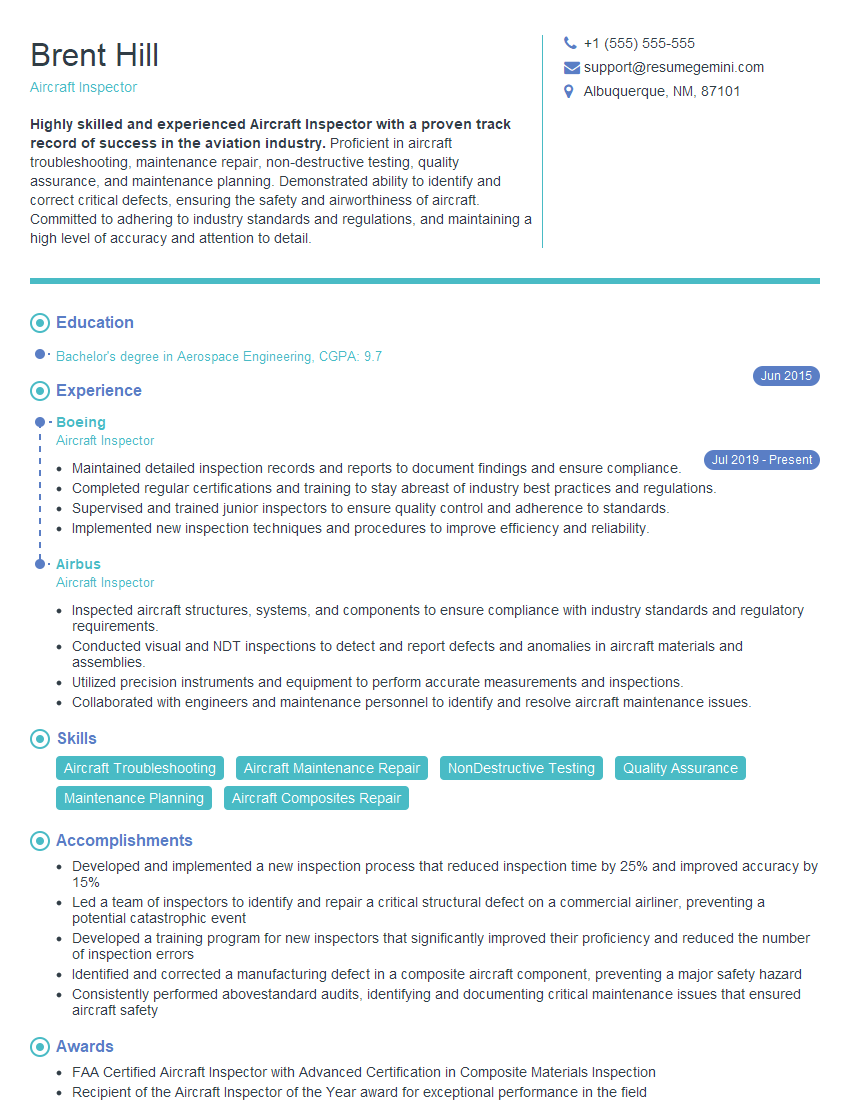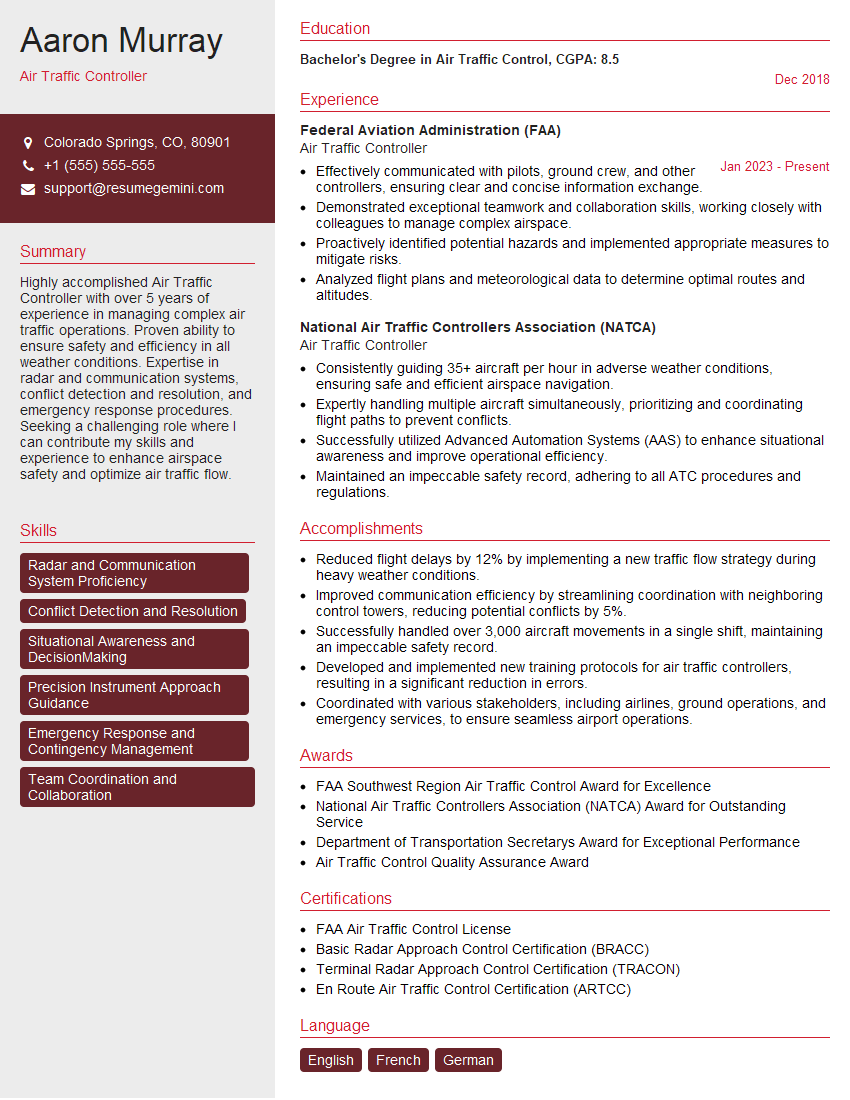Interviews are opportunities to demonstrate your expertise, and this guide is here to help you shine. Explore the essential Knowledge of aircraft types and configurations interview questions that employers frequently ask, paired with strategies for crafting responses that set you apart from the competition.
Questions Asked in Knowledge of aircraft types and configurations Interview
Q 1. Describe the differences between a narrow-body and a wide-body aircraft.
The primary difference between narrow-body and wide-body aircraft lies in their fuselage cross-section. Narrow-body aircraft, like the Boeing 737 or Airbus A320, have a single aisle separating the passenger seats. This limits passenger capacity but allows for efficient operation on shorter, less busy routes. Wide-body aircraft, such as the Boeing 777 or Airbus A350, feature a wider fuselage with two aisles, significantly increasing passenger and cargo capacity. This makes them ideal for long-haul flights and high-density routes. Think of it like comparing a minivan (narrow-body) to a large passenger bus (wide-body) – both transport people, but the bus carries many more.
This difference affects various aspects of the aircraft, including fuel efficiency (narrow-body aircraft are generally more fuel-efficient per passenger), range (wide-body aircraft usually have greater range), and overall cost of operation. The choice between narrow-body and wide-body depends heavily on the airline’s operational requirements and the routes they serve.
Q 2. Explain the significance of aircraft weight and balance.
Aircraft weight and balance is critical for safe and efficient flight. It involves precisely determining the aircraft’s total weight and the location of its center of gravity (CG). An aircraft’s CG must remain within specified limits during all phases of flight; otherwise, it can lead to instability, reduced maneuverability, and even catastrophic failure. Imagine balancing a pencil on your finger – a slight shift changes the balance drastically. Similarly, an aircraft’s weight and balance is meticulously calculated before each flight, taking into account factors like fuel, passengers, cargo, and baggage.
Weight and balance calculations ensure the aircraft performs as expected, reducing stress on the airframe and enhancing fuel efficiency. Airlines use sophisticated software and detailed weight records to manage this process. Deviation from the approved weight and balance limits can lead to flight restrictions or even grounding of the aircraft.
Q 3. What are the key components of a typical aircraft flight control system?
A typical aircraft flight control system is a complex network of components working in harmony to allow pilots to control the aircraft’s attitude and flight path. Key components include:
- Control Surfaces: These are movable aerodynamic surfaces like ailerons (for roll control), elevators (for pitch control), and rudders (for yaw control).
- Flight Controls: The stick or yoke, rudder pedals, and trim controls in the cockpit allow the pilot to manipulate the control surfaces.
- Actuators: These are the mechanisms (often hydraulic or electric) that translate pilot commands into movement of the control surfaces.
- Control System Computers (Fly-by-wire): Many modern aircraft use fly-by-wire systems where computers interpret pilot inputs and send signals to the actuators. This enhances safety and precision.
- Sensors: Various sensors measure the aircraft’s attitude, airspeed, and other parameters, providing feedback to the control system.
The interaction of these components ensures precise control and stability throughout the flight, from takeoff to landing. Malfunctions in any part of this system can have serious consequences, emphasizing the importance of regular maintenance and inspections.
Q 4. Discuss the various types of aircraft engines and their applications.
Aircraft engines can be broadly classified into several types, each with its own applications:
- Reciprocating Engines: These piston engines are relatively simple and were common in early aviation. They are still used in smaller general aviation aircraft due to their simplicity and cost-effectiveness. Examples include Lycoming and Continental engines.
- Turboprop Engines: These use a turbine to drive a propeller, providing efficient thrust at lower speeds. They are widely used in regional airliners and smaller cargo planes.
- Turbofan Engines: These are the most common type of engine in modern commercial airliners. They use a large fan to accelerate a significant amount of air, improving fuel efficiency and thrust at higher speeds. Examples include CFM International LEAP and Rolls-Royce Trent engines.
- Turbojet Engines: These engines produce thrust by accelerating a high-velocity jet stream. They were dominant in earlier jet aircraft but are less common now due to their lower fuel efficiency compared to turbofans.
- Ramjet Engines: These are air-breathing engines that rely on the forward speed of the aircraft to compress the incoming air. They are used in specialized high-speed applications such as missiles.
- Scramjet Engines: These are a further development of ramjets designed for hypersonic flight, where air is compressed supersonically.
The choice of engine type depends heavily on the aircraft’s size, speed, range, and intended mission profile.
Q 5. Explain the difference between a turbofan and a turboprop engine.
Both turbofan and turboprop engines are gas turbine engines, but they differ significantly in how they produce thrust. A turbofan engine uses a large fan at the front to accelerate a large volume of air, producing thrust primarily through this airflow. A smaller portion of the air is compressed and burned in the core of the engine, contributing additional thrust. This results in high efficiency at higher speeds and altitudes, making them ideal for large passenger jets.
A turboprop engine uses a turbine to drive a propeller. This propeller accelerates a large mass of air, generating thrust. Turboprops are more efficient at lower speeds and altitudes, making them suitable for smaller aircraft and regional airliners. Think of it like comparing a powerful fan (turbofan) to a large, rotating paddle (turboprop) – both create movement, but the method is different and affects performance.
Q 6. Describe the function of the aircraft’s hydraulic system.
The aircraft’s hydraulic system is a crucial component that provides power for various essential functions, particularly those related to flight control. It uses high-pressure hydraulic fluid to actuate components like flight control surfaces (ailerons, elevators, rudder), landing gear, brakes, and spoilers. This system ensures smooth and precise control of these critical functions. Imagine it as the muscles of the aircraft.
Hydraulic systems offer high power-to-weight ratios, making them ideal for aircraft applications. Multiple independent hydraulic systems are usually present to enhance redundancy and safety. If one system fails, the others can maintain critical functionality, avoiding catastrophic failure. Regular maintenance and inspections are crucial to ensure the system’s reliability and prevent leaks or failures.
Q 7. What are the different types of landing gear configurations?
Aircraft landing gear configurations vary depending on the aircraft’s size, weight, and operational requirements. Common types include:
- Tricycle Gear: This is the most common configuration, consisting of two main landing gears under the wings and a nose gear at the front. This provides good ground handling and visibility during taxiing and takeoff.
- Conventional (Tailwheel) Gear: This configuration features two main landing gears and a tailwheel. While less common in modern airliners, it’s still used in some general aviation aircraft. It requires more pilot skill for takeoff and landing.
- Tandem Gear: In this arrangement, the main landing gears are placed one behind the other. This is often used in specialized aircraft like some amphibious planes.
- Bicycle Gear: This configuration has two main landing gears located close together under the fuselage. It’s used on smaller aircraft.
The choice of landing gear configuration is a crucial design consideration, impacting the aircraft’s stability, ground handling characteristics, and overall safety during ground operations.
Q 8. Explain the purpose of flaps and slats during takeoff and landing.
Flaps and slats are high-lift devices crucial for takeoff and landing. They increase the wing’s surface area and curvature, generating significantly more lift at lower speeds. During takeoff, deploying flaps and slats allows the aircraft to achieve sufficient lift for shorter takeoff runs. Similarly, during landing, they enable the aircraft to approach and land at slower speeds, enhancing safety and maneuverability.
Think of it like this: imagine trying to run and jump a long distance versus a short one. Flaps and slats act like giving you a bigger, more powerful springboard, allowing for a shorter run-up and a softer landing.
- Flaps: These hinged surfaces on the trailing edge of the wing extend downwards, increasing the wing’s camber (curvature) and generating increased lift.
- Slats: These are located on the leading edge of the wing and extend forward, increasing the wing’s effective chord (length) and reducing airflow separation at higher angles of attack, thus increasing lift at high angles of attack (needed for low-speed flight).
Different aircraft utilize various flap and slat configurations, depending on their size and design. For example, a large airliner might have multiple slotted flaps and leading-edge slats for maximum lift augmentation, whereas a smaller general aviation aircraft might have simpler flap systems.
Q 9. Describe the principles of Bernoulli’s principle in relation to aircraft lift.
Bernoulli’s principle is fundamental to understanding aircraft lift. It states that an increase in the speed of a fluid (like air) occurs simultaneously with a decrease in pressure or a decrease in the fluid’s potential energy. The air flowing over the curved upper surface of an airfoil (the wing’s cross-section) travels a longer distance than the air flowing underneath. This results in faster airflow over the top and slower airflow underneath. According to Bernoulli’s principle, the faster airflow on top creates a region of lower pressure, while the slower airflow underneath creates a region of higher pressure. This pressure difference generates an upward force, known as lift, that counteracts the aircraft’s weight.
Imagine blowing air across a piece of paper held at one end. The air moving quickly on top creates a lower pressure, while the air underneath remains at higher pressure, causing the paper to lift.
It’s important to note that while Bernoulli’s principle explains a significant portion of lift generation, it doesn’t fully account for it. The concept of ‘downwash,’ where air is deflected downwards by the wing, also contributes substantially to lift.
Q 10. What are the main structural components of an aircraft fuselage?
The aircraft fuselage, essentially the body of the aircraft, is a complex structure comprising several key components:
- Frames: These are circular or semi-circular rings that provide structural support around the fuselage’s circumference.
- Stringers: These are longitudinal members running along the length of the fuselage, providing additional strength and stiffness.
- Skin: This is the outer covering of the fuselage, typically made of aluminum alloy, composite materials, or a combination. It provides an aerodynamic surface and protects the internal structure.
- Bulkheads: These are strong, often transverse, partitions used to divide the fuselage into compartments, providing additional support and safety features (like firewalls).
- Longerons: These are the strongest longitudinal structural members within the fuselage providing primary load bearing capacity.
The specific arrangement and materials used in the fuselage structure depend on the aircraft type, size, and intended use. Larger aircraft often employ more complex fuselage designs to accommodate higher passenger loads and longer ranges.
Q 11. Explain the concept of Centre of Gravity (CG) and its importance.
The Centre of Gravity (CG) is the average point where the weight of an aircraft acts. It’s crucial for stability and control. If the CG is too far forward, the aircraft will be difficult to pitch up (raise the nose), and it might even lead to a stall at higher angles of attack. If the CG is too far aft (rearward), it can make the aircraft excessively sensitive to control inputs, making it harder to control and potentially leading to instability, and ultimately a loss of control.
Imagine a seesaw; the CG is the point where the seesaw balances. If the weight distribution is uneven, the seesaw will tilt. Similarly, an aircraft’s CG needs to be within specified limits for proper flight characteristics. This is why aircraft manufacturers specify an acceptable range for the CG, and pilots must ensure the aircraft’s weight and balance are within those limits before flight.
Maintaining the CG within the specified limits is vital for safe and efficient flight, impacting performance, stability, and maneuverability.
Q 12. Describe the different types of aircraft wings and their aerodynamic characteristics.
Aircraft wings come in various shapes and configurations, each with unique aerodynamic characteristics:
- Rectangular Wings: Simple, easy to manufacture, but less efficient at high speeds.
- Elliptical Wings: Minimize induced drag (drag created by the wingtip vortices), offering superior efficiency, but complex to manufacture.
- Tapered Wings: Gradually reduce the wingspan towards the wingtip, combining the benefits of both rectangular and elliptical wings (compromise between efficiency and manufacturing).
- Swept Wings: Wings that sweep backward, improving high-speed stability and reducing transonic drag (drag encountered near the speed of sound).
- Delta Wings: Triangular wings offering excellent maneuverability at high angles of attack, typically used in high-speed aircraft.
The choice of wing design is influenced by the aircraft’s intended speed range, maneuverability requirements, and overall performance goals. For instance, supersonic aircraft often feature swept or delta wings to minimize high-speed drag, while slower, more maneuverable aircraft might employ rectangular or tapered wings.
Q 13. What are the limitations of different aircraft types regarding payload and range?
Payload and range limitations are directly linked to aircraft design and type. Factors such as aircraft size, weight, engine power, and aerodynamic efficiency all play a critical role.
- General Aviation Aircraft: Typically have smaller payloads and shorter ranges due to their smaller size and less powerful engines.
- Regional Airliners: Offer larger payloads and increased ranges than general aviation aircraft, but are still limited compared to larger airliners.
- Large Airliners: Possess the highest payload and range capabilities owing to their larger size, more powerful engines, and optimized aerodynamic designs.
For example, a small single-engine aircraft might carry a payload of a few hundred kilograms and have a range of a few hundred kilometers, whereas a large airliner can carry hundreds of passengers and several tons of cargo over thousands of kilometers.
These limitations are often governed by structural strength, fuel capacity, and regulatory constraints.
Q 14. How does aircraft design affect fuel efficiency?
Aircraft design significantly impacts fuel efficiency. Several factors contribute:
- Aerodynamics: A more streamlined design with reduced drag, optimized wing shapes, and advanced high-lift devices directly improves fuel efficiency. Reducing parasitic drag (drag from non-lifting components) is key.
- Weight: Lighter aircraft require less energy to fly. Using lightweight materials and efficient designs minimize the aircraft’s overall weight.
- Engine Technology: Modern, fuel-efficient engines with higher bypass ratios significantly improve fuel consumption. Advanced materials and improved combustion processes contribute to efficiency.
- Flight Operations: Optimized flight paths, efficient climb and descent profiles, and proper air traffic management contribute to fuel savings.
For instance, the use of composite materials in modern aircraft reduces weight, improving fuel efficiency. Similarly, the adoption of more fuel-efficient engines has allowed airlines to reduce their operating costs and environmental impact.
Q 15. Explain the function of the aircraft’s electrical system.
An aircraft’s electrical system is the nervous system of the plane, providing power for virtually every essential function, from lighting and avionics to flight controls and engine starting. Think of it like the electrical grid in a city, but far more sophisticated and safety-critical.
It typically comprises several key components: generators (usually driven by the engines), batteries (providing backup power), power distribution systems (managing power flow), and various electrical loads (devices consuming power). These systems are carefully designed with redundancy – backup systems are in place to ensure continued operation even if one component fails. For example, a large airliner might have multiple generators and batteries to ensure that a single failure won’t cripple the entire electrical system.
The system’s complexity varies greatly depending on the aircraft size and mission. A small general aviation aircraft might have a simpler system, while a large airliner will have a highly complex and redundant network.
Career Expert Tips:
- Ace those interviews! Prepare effectively by reviewing the Top 50 Most Common Interview Questions on ResumeGemini.
- Navigate your job search with confidence! Explore a wide range of Career Tips on ResumeGemini. Learn about common challenges and recommendations to overcome them.
- Craft the perfect resume! Master the Art of Resume Writing with ResumeGemini’s guide. Showcase your unique qualifications and achievements effectively.
- Don’t miss out on holiday savings! Build your dream resume with ResumeGemini’s ATS optimized templates.
Q 16. What are the different types of aircraft communication systems?
Aircraft communication systems are vital for safe and efficient flight operations. They allow pilots to communicate with air traffic control (ATC), other aircraft, and ground personnel. These systems range from simple VHF (Very High Frequency) radios to sophisticated satellite communication systems.
- VHF Radio: This is the most common form of communication for shorter ranges, used for communicating with ATC and other aircraft in the vicinity. Think of it like a walkie-talkie, but with much higher reliability and range.
- HF (High Frequency) Radio: Used for long-range communication, particularly over oceans where VHF is ineffective. It relies on ground-based radio stations and can be impacted by atmospheric conditions.
- Satellite Communication Systems: These systems allow for communication virtually anywhere in the world, even over remote areas with no ground-based infrastructure. They’re often used for data transmission, including weather reports and flight information.
- ACARS (Aircraft Communications Addressing and Reporting System): A digital data link system that allows for automated data exchange between aircraft and ground stations. This is how airlines often get real-time flight data, including technical information from the aircraft.
The specific systems used depend on the aircraft type and mission. For instance, a small private aircraft might only use VHF radio, while a long-haul airliner will employ a combination of VHF, HF, and satellite communication systems.
Q 17. Describe the operation of an aircraft’s anti-ice and de-icing systems.
Aircraft anti-ice and de-icing systems are crucial for safe operation in icing conditions. Ice accumulation on wings and control surfaces can dramatically reduce lift and controllability, posing a serious safety hazard. These systems prevent or remove ice buildup.
De-icing involves removing ice that has already formed. This is often done on the ground using fluids applied to the aircraft’s surfaces before takeoff. These fluids temporarily prevent ice from adhering.
Anti-icing systems prevent ice from forming. These systems are active during flight and include:
- Pneumatic boots: Inflatable rubber boots on the leading edges of wings and tail surfaces that periodically inflate, cracking and shedding any accumulating ice.
- Thermal anti-ice: Electric heating elements embedded in the wings and control surfaces that melt any forming ice. This system is energy-intensive but highly effective.
- Fluid anti-ice: A heated fluid is circulated through the wings and control surfaces to prevent ice formation.
The specific system or combination used depends on the aircraft type and operating conditions. For example, smaller aircraft might rely on pneumatic boots, while larger aircraft might use a combination of thermal anti-ice and fluid anti-ice.
Q 18. Explain the principles of flight stability and control.
Flight stability and control are fundamental to safe and efficient flight. Stability refers to an aircraft’s tendency to return to its original flight path after a disturbance, while control refers to the pilot’s ability to maneuver the aircraft. Imagine a bicycle: a stable bike is easy to balance; a controllable bike allows you to steer and brake as desired.
Stability is achieved through aerodynamic design. The aircraft’s center of gravity and the distribution of lift and drag forces determine its stability characteristics. A stable aircraft will naturally correct small deviations from its intended flight path.
Control is achieved through flight control surfaces (discussed in the next question) that allow the pilot to adjust the aircraft’s attitude (orientation) and trajectory. These surfaces, such as ailerons, elevators, and rudder, generate forces that enable maneuvers such as turns, climbs, and descents.
Stability and control are intertwined. A highly stable aircraft might be harder to maneuver, while a highly maneuverable aircraft might be less stable. Aircraft designers carefully balance these factors to optimize both safety and performance.
Q 19. What are the various types of flight control surfaces?
Flight control surfaces are movable aerodynamic surfaces used to control an aircraft’s attitude and trajectory. They work by manipulating airflow to generate forces that change the aircraft’s orientation and motion.
- Ailerons: Located on the trailing edges of the wings, ailerons move in opposite directions to create a rolling moment, causing the aircraft to bank (tilt) left or right. Imagine pushing one aileron down creating extra lift on that wing to make the plane roll.
- Elevators: Located on the horizontal stabilizer (tailplane), elevators control pitch (nose up or down). Moving them up pitches the nose up, increasing the aircraft’s climb angle.
- Rudder: Located on the vertical stabilizer (fin), the rudder controls yaw (nose left or right), primarily affecting the aircraft’s heading during turns.
- Flaps: These high-lift devices increase lift at lower speeds, facilitating takeoff and landing. They are typically located on the trailing edge of the wings and extend downwards.
- Slats: Located on the leading edge of the wings, slats extend forward, increasing lift and delaying stall speed in a similar manner to flaps.
The interaction between these surfaces allows pilots to accurately control the aircraft’s three-dimensional movement, making smooth and precise maneuvers possible.
Q 20. What are the key factors influencing aircraft performance?
Aircraft performance is a complex interplay of many factors that influence speed, altitude, range, and fuel efficiency. These factors can be broadly categorized as:
- Aerodynamic Factors: The shape and design of the aircraft, including wing area, aspect ratio, and airfoil shape, significantly influence lift, drag, and overall performance. A more streamlined design will typically improve fuel efficiency.
- Weight and Balance: The total weight of the aircraft, including fuel, payload, and structural components, significantly impacts its performance. The distribution of weight (center of gravity) also affects stability and control.
- Propulsion System: The type and efficiency of the engines determine the amount of thrust generated, directly impacting speed, climb rate, and range. More powerful engines can allow for heavier payloads.
- Atmospheric Conditions: Air density (affected by altitude and temperature), wind speed, and wind direction all affect aircraft performance. Air density is critically important for lift generation.
- Altitude and Temperature: Higher altitudes have lower air density, reducing lift and engine efficiency. Similarly, higher temperatures impact engine performance.
Optimizing aircraft performance involves considering all these factors in tandem. For example, a heavier aircraft might need a longer runway for takeoff, and its top speed will also be lower due to greater drag.
Q 21. Describe the different types of aircraft navigation systems.
Aircraft navigation systems guide pilots from one point to another, ensuring safe and efficient flight. These systems have evolved from simple visual navigation to highly sophisticated satellite-based systems.
- VOR (Very High Frequency Omnidirectional Range): A ground-based radio navigation system that provides bearing information to aircraft. It’s part of the older system of ground based navigation aids.
- ILS (Instrument Landing System): A ground-based system that provides precise guidance for landing in low visibility conditions. It works by emitting radio signals which guide an aircraft to the runway.
- GPS (Global Positioning System): A satellite-based navigation system that provides highly accurate position information anywhere on Earth. This is now the dominant form of aircraft navigation.
- RNAV (Area Navigation): A more sophisticated form of navigation that utilizes GPS and other technologies to enable flight along predetermined routes and approaches, allowing pilots to navigate more efficiently and flexibly.
- Inertial Navigation System (INS): This system uses sensors to measure aircraft acceleration and rotation and calculates its position without relying on external signals. Though usually more expensive and not as accurate as GPS on its own it offers great backup capability and works regardless of external factors, such as GPS signal loss.
Modern aircraft typically utilize a combination of these systems, providing redundancy and backup in case of failure. For example, a flight might primarily rely on GPS, but use INS as a backup and VOR/ILS for approach and landing procedures.
Q 22. Explain the significance of aircraft certification and airworthiness.
Aircraft certification and airworthiness are paramount for ensuring the safety and reliability of flight. Certification, overseen by aviation authorities like the FAA (Federal Aviation Administration) or EASA (European Union Aviation Safety Agency), is a rigorous process verifying that an aircraft design meets stringent safety standards. This involves extensive testing and analysis across various aspects, from structural integrity and systems functionality to performance capabilities and emergency procedures. Airworthiness, on the other hand, refers to the ongoing condition of an aircraft, ensuring it remains compliant with these standards throughout its operational life. This requires regular inspections, maintenance, and adherence to airworthiness directives (ADs) – mandatory actions issued by regulatory bodies to address potential safety issues.
Think of it like this: certification is like the graduation certificate for an aircraft design, proving it meets all the requirements. Airworthiness is like keeping up with your annual check-up; it confirms the aircraft is still healthy and safe for operation.
Q 23. How does the aircraft’s configuration affect its performance during different phases of flight?
Aircraft configuration significantly impacts performance throughout flight. Consider the flaps and slats – high-lift devices deployed during takeoff and landing. These increase the wing’s surface area, generating more lift at lower speeds, crucial for shorter runways. Similarly, the landing gear position affects drag; retracted gear minimizes drag during cruise, improving fuel efficiency. The aircraft’s weight distribution, affected by fuel burn and cargo loading, impacts stability and maneuverability. During climb, a high angle of attack maximizes lift-to-drag ratio, allowing efficient ascent. In cruise, a lower angle of attack optimizes speed and fuel economy. Finally, the configuration is crucial for approach and landing, adjusting lift and drag to achieve a safe and controlled descent.
For instance, a heavy aircraft with full fuel tanks and cargo will require a longer takeoff run and higher approach speed than a lighter one. Incorrect flap settings during landing could result in a stall or a hard landing.
Q 24. What are the safety implications of incorrect aircraft configuration?
Incorrect aircraft configuration carries severe safety implications. For example, deploying flaps at high speed can lead to structural damage and loss of control. Conversely, failing to deploy flaps for landing significantly increases landing speed and distance, increasing the risk of overrunning the runway. Incorrect weight and balance can impact stability, causing difficulty in controlling the aircraft and potentially leading to accidents. Furthermore, improper configuration can compromise the effectiveness of critical systems such as the flight control surfaces and engines.
A real-world example is the Air France Flight 447 accident, partially attributed to pilot error in handling icing conditions and stall recovery. This highlights the crucial role of proper configuration and pilot training in preventing accidents.
Q 25. Describe different types of aircraft materials and their properties.
Aircraft construction utilizes a variety of materials, each with specific properties. Aluminum alloys have been the workhorse for decades due to their high strength-to-weight ratio and corrosion resistance. However, newer aircraft increasingly incorporate composite materials, such as carbon fiber reinforced polymers (CFRP). These offer superior strength, stiffness, and fatigue resistance, leading to lighter airframes and improved fuel efficiency. Titanium alloys are used in high-stress areas requiring exceptional strength and heat resistance, such as engine components. Steel remains vital for certain structural elements requiring high strength and impact resistance.
The choice of material depends on the specific requirements of the aircraft and component. For example, CFRP is ideal for wings and fuselage sections, while titanium alloys are better suited for engine components and high-temperature applications.
Q 26. Explain the role of the flight management system (FMS).
The Flight Management System (FMS) is a sophisticated onboard computer system that automates many aspects of flight, improving safety and efficiency. It integrates navigation, performance calculations, and flight planning functions. The FMS calculates optimal flight paths, considering factors like wind, weather, and air traffic control restrictions. It provides guidance to the pilots through various flight phases, automating tasks like altitude and speed management. The system also aids in fuel management, helping optimize fuel consumption for the flight. It also contains a database of navigation data, including airports, airways, and terrain information.
Imagine an FMS as a highly advanced GPS combined with a sophisticated flight planner and performance calculator, all working together to make the flight safer and more fuel-efficient.
Q 27. What are the various types of auxiliary power units (APU)?
Auxiliary Power Units (APUs) are self-contained power generation systems onboard aircraft, providing power for various functions when the main engines are off. They typically consist of a small turbine engine driving a generator. There are primarily two types: gas turbine APUs and electric APUs. Gas turbine APUs are more common, offering higher power output for functions like air conditioning, starting the main engines, and providing electrical power. Electric APUs, while less common, offer benefits in terms of reduced noise and emissions. The choice depends on the aircraft size, mission requirements, and environmental concerns.
Think of the APU as a backup generator for the airplane, ensuring essential systems remain operational even when the main engines are not running.
Q 28. Describe the process of aircraft maintenance scheduling.
Aircraft maintenance scheduling is a critical aspect of airworthiness management. It follows a structured approach, often based on scheduled maintenance programs defined by the manufacturer and regulatory authorities. These programs outline specific inspections and maintenance tasks at prescribed intervals, often based on flight hours or calendar time. They include tasks like routine inspections, component replacements, and more extensive overhauls. Computerized Maintenance Management Systems (CMMS) are widely used to track maintenance activities, manage spare parts inventory, and ensure compliance with regulatory requirements. The schedule considers factors like the type of aircraft, operational environment, and usage intensity. A robust maintenance schedule minimizes downtime, maximizes safety, and ensures the aircraft’s continued airworthiness.
A well-planned maintenance schedule is like a preventative healthcare plan for an aircraft, ensuring it stays in optimal condition and avoids unexpected breakdowns.
Key Topics to Learn for Knowledge of Aircraft Types and Configurations Interview
- Aircraft Classifications: Understand the different categories of aircraft (e.g., fixed-wing, rotary-wing, VTOL) and their defining characteristics. Be prepared to discuss the advantages and disadvantages of each type.
- Airframe Design & Construction: Familiarize yourself with common airframe materials (e.g., aluminum, composites), structural components (e.g., fuselage, wings, empennage), and their impact on aircraft performance and maintenance.
- Aerodynamic Principles: Demonstrate a grasp of fundamental aerodynamic concepts like lift, drag, thrust, and weight, and how they relate to aircraft design and flight characteristics. Be ready to discuss their influence on aircraft performance in different flight regimes.
- Engine Types & Propulsion Systems: Know the differences between various engine types (e.g., piston, turboprop, turbojet, turbofan) and their applications in different aircraft. Understand the principles of thrust generation and fuel efficiency.
- Aircraft Systems: Gain a working knowledge of key aircraft systems, including flight controls, navigation systems, communication systems, and environmental control systems. Be able to discuss their functions and interdependencies.
- Performance Characteristics: Understand how factors such as weight, altitude, temperature, and wind affect aircraft performance (speed, range, climb rate). Be able to interpret performance charts and data.
- Aircraft Configurations & Variations: Explore different aircraft configurations (e.g., high-wing, low-wing, canard) and their impact on stability and control. Discuss the various design considerations that lead to different configurations for specific roles.
- Problem-Solving & Analytical Skills: Practice applying your knowledge to solve practical problems related to aircraft performance, maintenance, or operational issues. This could involve analyzing flight data or troubleshooting malfunctions.
Next Steps
Mastering knowledge of aircraft types and configurations is crucial for advancing your career in aviation. A strong understanding of these concepts demonstrates technical proficiency and problem-solving skills highly valued by employers. To maximize your job prospects, create an ATS-friendly resume that effectively highlights your expertise. ResumeGemini is a trusted resource that can help you build a professional and impactful resume tailored to the aviation industry. Examples of resumes tailored to showcasing expertise in aircraft types and configurations are available to guide you.
Explore more articles
Users Rating of Our Blogs
Share Your Experience
We value your feedback! Please rate our content and share your thoughts (optional).
What Readers Say About Our Blog
Hi, I represent an SEO company that specialises in getting you AI citations and higher rankings on Google. I’d like to offer you a 100% free SEO audit for your website. Would you be interested?
Dear Sir/Madam,
Do you want to become a vendor/supplier/service provider of Delta Air Lines, Inc.? We are looking for a reliable, innovative and fair partner for 2025/2026 series tender projects, tasks and contracts. Kindly indicate your interest by requesting a pre-qualification questionnaire. With this information, we will analyze whether you meet the minimum requirements to collaborate with us.
Best regards,
Carey Richardson
V.P. – Corporate Audit and Enterprise Risk Management
Delta Air Lines Inc
Group Procurement & Contracts Center
1030 Delta Boulevard,
Atlanta, GA 30354-1989
United States
+1(470) 982-2456


